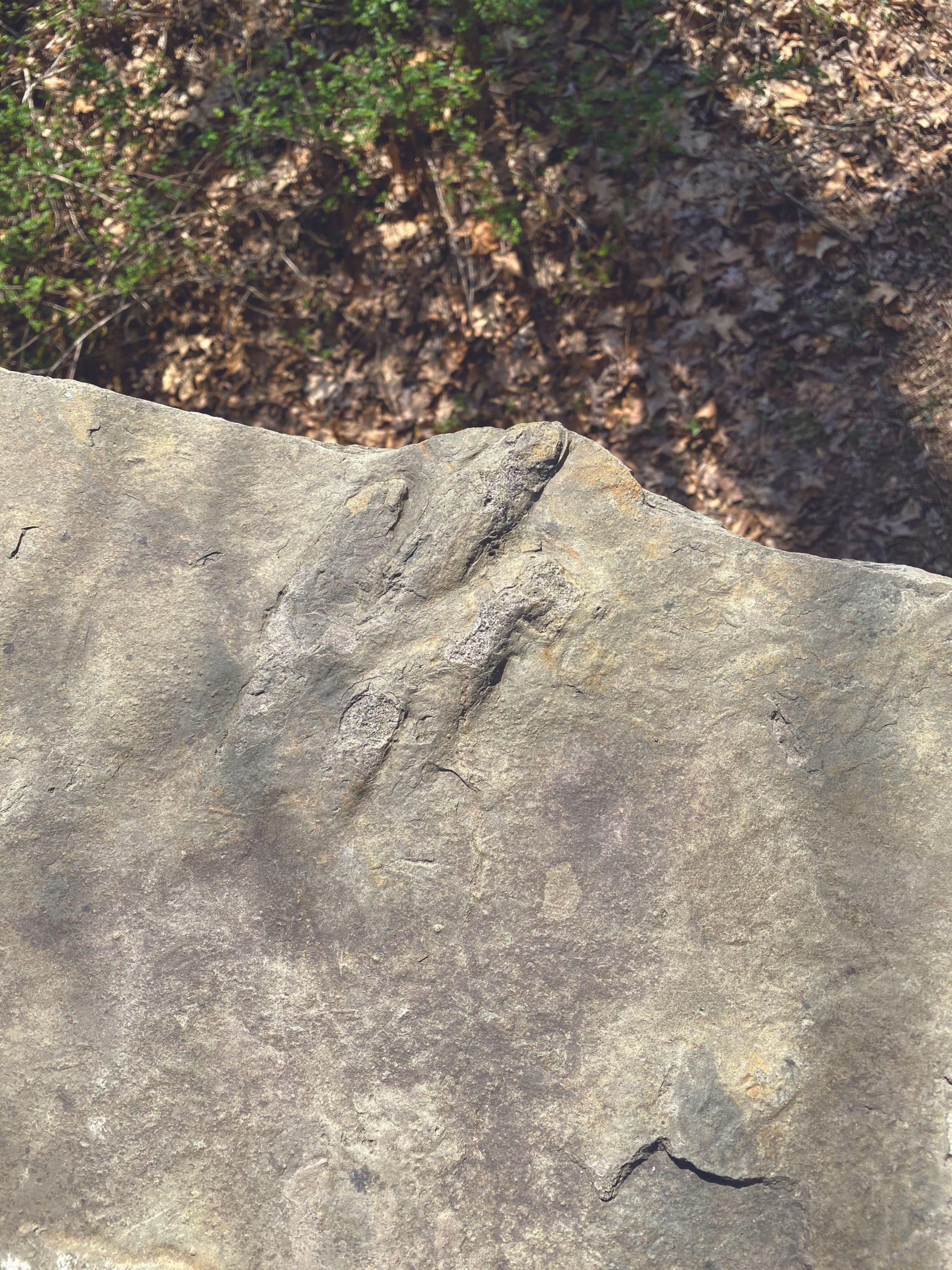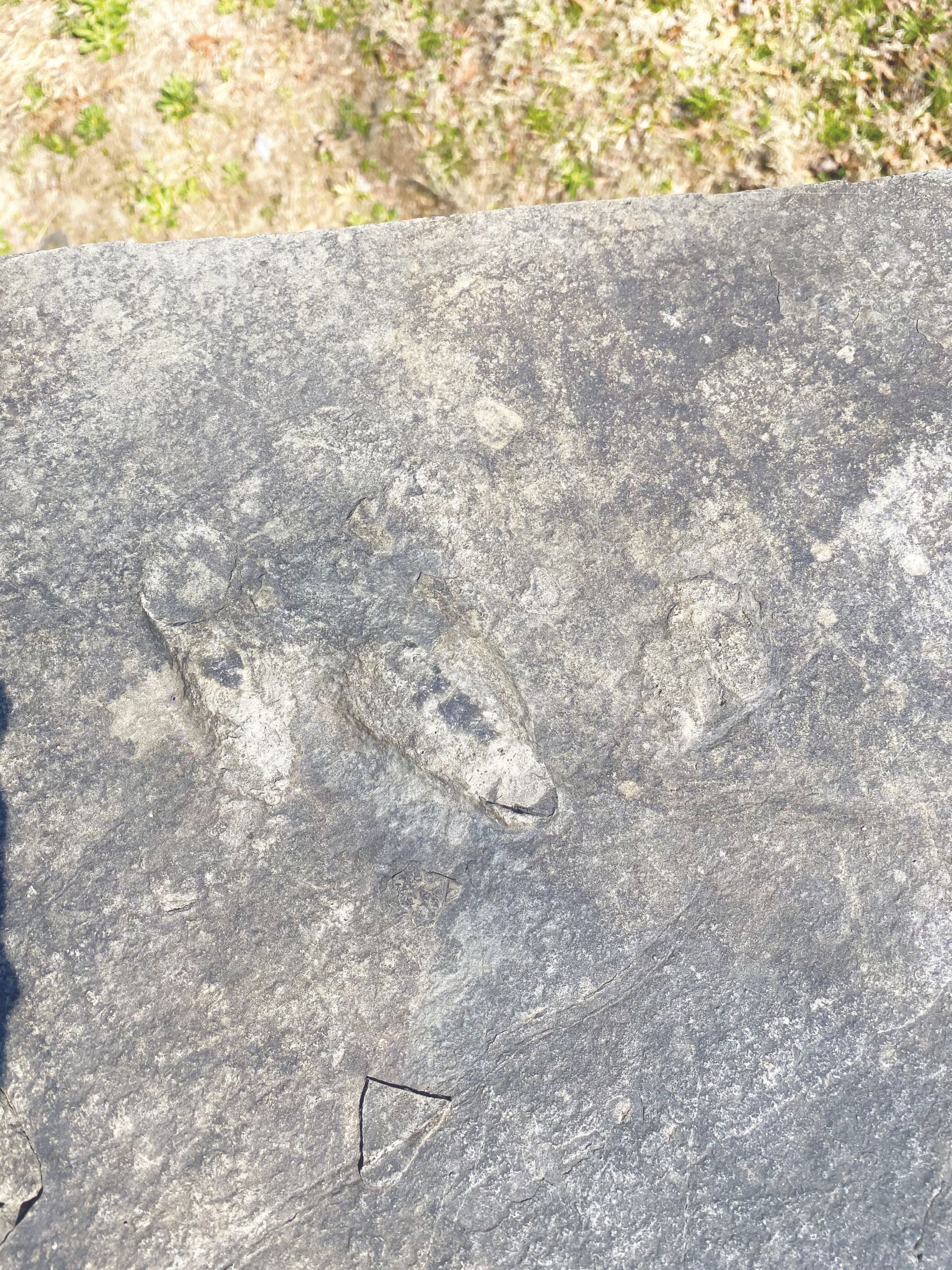Gettysburg's Dinosaur Bridge
by Diana Loski
Gettysburg’s history, it seems, transcends human history – evident in at least one area of the battlefield. Traveling from South Confederate Avenue while on the ascent to Big Round Top, visitors to the field inevitably cross a stone bridge where Plum Run meanders. When the stone was harvested for the bridge in the late 19th century, the quarry was in Adams County, north of Gettysburg near York Springs. When the bridge was completed in 1890, the stonemasons must have noticed ancient markings. One stonecutter deliberately elongated the stone to keep the unusual print intact. 1
There are the footprints of two different species of dinosaurs from the Triassic Period easily seen on Gettysburg’s Dinosaur Bridge.
The Triassic Period of the ancient Mesozoic Era is the earliest period where dinosaurs, according to recent science, first existed. The Triassic (250-200 million years ago) was followed by the Jurassic (199-145 million years ago) and the Cretaceous (145-65 million years ago) Periods. The latter two are known as “The Age of the Dinosaurs”. The earlier Triassic period, though, also contained some species of these amazing creatures.2
The prints on the bridge to Big Round Top are that of the Anchisauripus, a medium-sized carnivore that walked on two legs, and the Atreipus, a smaller herbivore. To date, no fossilized skeletal remains of these dinosaurs have been found, only the prints. It is conjectured that these animals probably lived during the late Triassic period, around 200 million years ago.
Adams County, Pennsylvania and northern York County, Pennsylvania form part of the Gettysburg Basin, a geologic area that houses remains of rare and ancient life from the Triassic Period. A thin geographic line from southwestern Adams County – beginning just beyond Fairfield and Carroll Valley where the South Mountains rise – travels diagonally to the northeast – ending at the tip of York and Lancaster Counties. These areas contain Triassic beds that are not found in any other part of Pennsylvania. Gettysburg is the center of these beds.3
The same area is also filled with rich sediment, rock formations, and fault lines. The outcroppings of large igneous rock are a popular site for visitors to Devil’s Den and the Round Tops. These outcroppings formed as a result of ancient volcanic activity rather than glacial deposits.4
To find the prints of the two dinosaurs, travel the one-way route on South Confederate Avenue toward Big Round Top. Access is possible from Seminary Ridge, heading straight on West Confederate Avenue, which turns automatically into South Confederate, crossing the Emmitsburg Road. Or, head south from town on Steinwehr Avenue (which is also the Emmitsburg Road) out of town, then turn left on South Confederate Avenue, about ½ mile south of the Peach Orchard. Follow the road to the end of the Confederate line that then continues in an ascent toward the Round Tops. (You are following the same path as the Alabama troops on the afternoon of Gettysburg’s second day.) There is parking available at the William Wells statue, located to the right of the road just before the bridge. (William Wells was a Union cavalry officer who participated in the ill-fated Farnsworth’s Charge nearby on the afternoon of July 3 – a less-known aspect of the Battle of Gettysburg). The stone bridge that spans Plum Run is directly ahead on the slope of the wooded Big Round Top.
The Anchisauripus print is found on the top of the sixth stone block to the right (east) part of the bridge. The print appears to point to the woods, which it faces. A slight extension and rounding of the stone are also easily visible.
To see the Atreipus print, cross the avenue to the left (west) portion of the bridge and walk to the very end. From the top left stone block, count back five blocks. The print will be seen on the fifth block from the end, also closer to the woods, but completely within the block.
Both prints are not indented, but raised. These claw-like footprints, each with an extended digit, are clearly seen, although the carnivorous dinosaur’s print is larger than the Atreipus’s print.
There are many unusual and less visited areas of Gettysburg’s historic battlefield. The Dinosaur Bridge is definitely Gettysburg’s most ancient site – whether travelers who cross Plum Run toward the wooded heights realize it or not.
There are the footprints of two different species of dinosaurs from the Triassic Period easily seen on Gettysburg’s Dinosaur Bridge.
The Triassic Period of the ancient Mesozoic Era is the earliest period where dinosaurs, according to recent science, first existed. The Triassic (250-200 million years ago) was followed by the Jurassic (199-145 million years ago) and the Cretaceous (145-65 million years ago) Periods. The latter two are known as “The Age of the Dinosaurs”. The earlier Triassic period, though, also contained some species of these amazing creatures.2
The prints on the bridge to Big Round Top are that of the Anchisauripus, a medium-sized carnivore that walked on two legs, and the Atreipus, a smaller herbivore. To date, no fossilized skeletal remains of these dinosaurs have been found, only the prints. It is conjectured that these animals probably lived during the late Triassic period, around 200 million years ago.
Adams County, Pennsylvania and northern York County, Pennsylvania form part of the Gettysburg Basin, a geologic area that houses remains of rare and ancient life from the Triassic Period. A thin geographic line from southwestern Adams County – beginning just beyond Fairfield and Carroll Valley where the South Mountains rise – travels diagonally to the northeast – ending at the tip of York and Lancaster Counties. These areas contain Triassic beds that are not found in any other part of Pennsylvania. Gettysburg is the center of these beds.3
The same area is also filled with rich sediment, rock formations, and fault lines. The outcroppings of large igneous rock are a popular site for visitors to Devil’s Den and the Round Tops. These outcroppings formed as a result of ancient volcanic activity rather than glacial deposits.4
To find the prints of the two dinosaurs, travel the one-way route on South Confederate Avenue toward Big Round Top. Access is possible from Seminary Ridge, heading straight on West Confederate Avenue, which turns automatically into South Confederate, crossing the Emmitsburg Road. Or, head south from town on Steinwehr Avenue (which is also the Emmitsburg Road) out of town, then turn left on South Confederate Avenue, about ½ mile south of the Peach Orchard. Follow the road to the end of the Confederate line that then continues in an ascent toward the Round Tops. (You are following the same path as the Alabama troops on the afternoon of Gettysburg’s second day.) There is parking available at the William Wells statue, located to the right of the road just before the bridge. (William Wells was a Union cavalry officer who participated in the ill-fated Farnsworth’s Charge nearby on the afternoon of July 3 – a less-known aspect of the Battle of Gettysburg). The stone bridge that spans Plum Run is directly ahead on the slope of the wooded Big Round Top.
The Anchisauripus print is found on the top of the sixth stone block to the right (east) part of the bridge. The print appears to point to the woods, which it faces. A slight extension and rounding of the stone are also easily visible.
To see the Atreipus print, cross the avenue to the left (west) portion of the bridge and walk to the very end. From the top left stone block, count back five blocks. The print will be seen on the fifth block from the end, also closer to the woods, but completely within the block.
Both prints are not indented, but raised. These claw-like footprints, each with an extended digit, are clearly seen, although the carnivorous dinosaur’s print is larger than the Atreipus’s print.
There are many unusual and less visited areas of Gettysburg’s historic battlefield. The Dinosaur Bridge is definitely Gettysburg’s most ancient site – whether travelers who cross Plum Run toward the wooded heights realize it or not.
Atreipus Track
Sources: Lawhon, Katie. “Assessment: Gettysburg’s Dinosaur Bridge, Big Round Top”. Gettysburg National Military Park. Shultz, Charles H., ed. The Geology of Pennsylvania . Harrisburg, PA: Pennsylvania Geological Survey, 1999. Weishampel, David B., ed. The Dinosauria . Berkeley and Los Angeles, CA: University of California Press, 2004.
End Notes:
1. Lawhon, p. 2. The bridge was restored and
refurbished in 1930.
2. Weishampel, p. 137.
3. Shultz, p. 441.
4. Ibid., p. 300.




